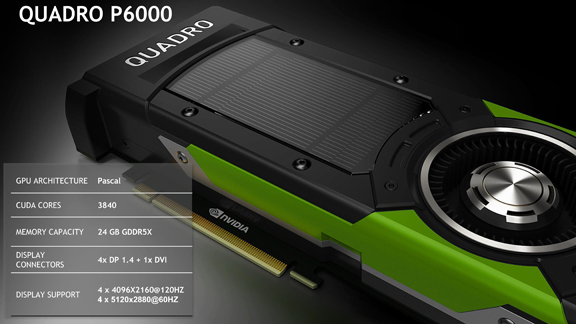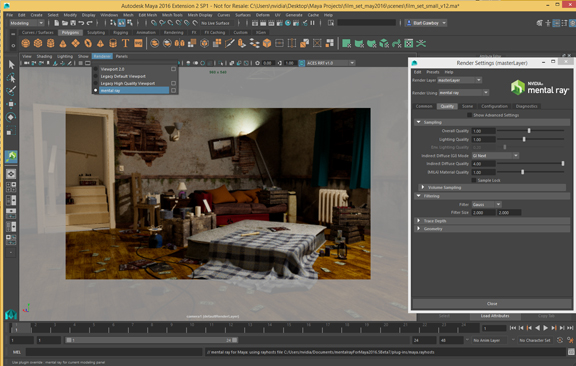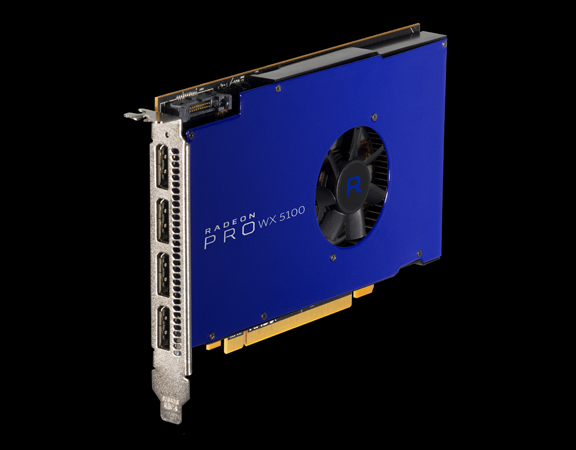
NVIDIA announced Quadro P6000, a PASCAL-generation GPU, at SIGGRAPH 2016 (image courtesy of NVIDIA).
Latest News
August 2, 2016
 NVIDIA plans to release a Mental Ray rendering plug-in for Autodesk Maya (image courtesy of NVIDIA).
NVIDIA plans to release a Mental Ray rendering plug-in for Autodesk Maya (image courtesy of NVIDIA). NVIDIA announced Quadro P6000, a PASCAL-generation GPU, at SIGGRAPH 2016 (image courtesy of NVIDIA).
NVIDIA announced Quadro P6000, a PASCAL-generation GPU, at SIGGRAPH 2016 (image courtesy of NVIDIA). AMD announced Radeon Pro WX 5100, part of a new series of GPUs, at SIGGRAPH 2016 (image courtesy of AMD).
AMD announced Radeon Pro WX 5100, part of a new series of GPUs, at SIGGRAPH 2016 (image courtesy of AMD).Now in its 43rd year, the SIGGRAPH conference last week brought graphics gurus, digital daredevils, 3D wizards, and pixel pushers to Anaheim, California. This year’s conference chair Mona Kasra from University of Virginia hailed the event as “an interdisciplinary point of connection, interaction, and collaboration among scholars, creatives and artists, researchers and industry professionals ... to celebrate and exchange ideas and practices in areas that include graphics, animation, interactivity, arts, virtual reality (VR), games, and much, much more.”
With a sizable pool of their target consumers assembled under the same roof, software and hardware vendors also lined up to showcase their star products.
Anticipating the rising demand for VR content, NVIDIA introduced what it calls “simultaneous multiprojection” in its PASCAL GPUs. The feature is expected to speed up VR content creation by rendering the left-eye view and right-eye view in a single pass.
PASCAL GPUs support display resolutions up to 8K (up to 7,680 x 4,320), the pixel-density standard for DisplayPort 1.4. For video wall installation, NVIDIA released Quadro Sync 2 card, which synchronizes the output of up to 8 PASCAL GPUs into a single artifact-free image.
The company is also releasing updates to its Iray rendering engine for 3dx Max, Maya, Rhino, and Cinema 4D. Iray is NVIDIA’s GPU-based rendering engine, It’s developed to produce photorealistic imagery by computing the behavior of light and materials. NVIDIA plans to ship Iray as a complimentary component in its deep-learning hardware DGX-1.
“DGX-1 is indeed for deep learning but can now also be used for visualization. DGX-1 with NVLink can drive the fastest GPU rendering available and will deliver interactive global illumination with Iray,” clarified Gail Laguna, NVIDIA’s senior PR manager. “NVLink technology provides a massive increase in GPU memory capacity by allowing GPU renderers to tap into the memory of four Tesla P100s in order to process large, complex scenes.”
Mental Ray, another rendering engine from NVIDIA, is set to become available as a plug-in for Autodesk Maya.
Iray takes advantage of the parallel processing power of NVIDIA GPUs. Mental Ray was previously CPU-based; however, in the Mental Ray plug-in for Maya, the addition of GI-Next solution brings GPU acceleration to the software. (For more, see NVIDIA’s blog post titled “NVIDIA Turbocharges mental ray Workflows and Final-Frame Rendering with GPU Acceleration.”)
NVIDIA Quadro P6000 and P5000, two new GPUs based on PASCAL architecture, are set to become available in October 2016. They will be offered by NVIDIA partners HP, Dell, and Lenovo in their workstation product lines.
At the same time, GPU maker AMD launched a new Radeon Pro WX series of professional GPUs, based on its Polaris architecture. The three products AMD is releasing are:
- Radeon Pro WX 7100, for design engineering, media and entertainment, and professional VR content creation;
- Radeon Pro WX 5100, for product development and design visualization;
- Radeon Pro WX 4100, for mid-range application performance in CAD.
The company also outlined its plan to offer its ProRender rendering engine to the open source community. AMD offers Radeon ProRender plug-ins for Autodesk 3ds Max, Dassault Systèmes SOLIDWORKS, and Rhino. It plans to release a version for Autodesk Maya soon.
Subscribe to our FREE magazine, FREE email newsletters or both!
Latest News
About the Author
Kenneth Wong is Digital Engineering’s resident blogger and senior editor. Email him at kennethwong@digitaleng.news or share your thoughts on this article at digitaleng.news/facebook.
Follow DE





